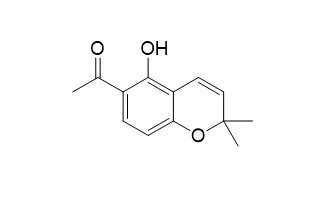| In vivo: |
| Molecules, 2017 Feb 14;22(2):289 | | Anti-Hyperglycemic Activity of Major Compounds from Calea ternifolia[Pubmed: 28216594] | | Demethylisoencecalin (1) and caleins A (4) and C (5) (3.16-31.6 mg/kg, p.o.), the major components from an infusion of Calea ternifolia controlled postprandial glucose levels during an oral sucrose tolerance test (OSTT, 3 g/kg) in normal and nicotinamide/streptozotocin (NA/STZ, 40/100 mg/kg) hyperglicemic mice. The effects were comparable to those of acarbose (5 mg/kg). During the isolation of 1, 4, and 5, four additional metabolites not previously reported for the plant, were obtained, namely 6-acetyl-5-hydroxy-2-methyl-2-hydroxymethyl-2H-chromene (3), herniarin (6), scoparone (7), and 4',7-dimethylapigenin (8). In addition, the structure of calein C (5) was confirmed by X-ray analysis. Pharmacological evaluation of the essential oil of the species (31.6-316.2 mg/kg, p.o.) provoked also an important decrement of blood glucose levels during an OSTT. Gas chromatography coupled with mass spectrometry (GC-MS) analysis of the headspace solid phase microextraction (HS-SPME)-adsorbed compounds and active essential oil obtained by hydrodistillation revealed that chromene 1 was the major component (19.92%); sesquiterpenes represented the highest percentage of the essential oil content (55.67%) and included curcumene (7.10%), spathulenol (12.95%) and caryophyllene oxide (13.0%). A suitable High Performance Liquid Chromatography (HPLC) method for quantifying chromenes 1 and 6-hydroxyacetyl-5-hydroxy-2,2-dimethyl-2H-chromene (2) was developed and validated according to standard protocols. |
|






 Cell. 2018 Jan 11;172(1-2):249-261.e12. doi: 10.1016/j.cell.2017.12.019.IF=36.216(2019)
Cell. 2018 Jan 11;172(1-2):249-261.e12. doi: 10.1016/j.cell.2017.12.019.IF=36.216(2019) Cell Metab. 2020 Mar 3;31(3):534-548.e5. doi: 10.1016/j.cmet.2020.01.002.IF=22.415(2019)
Cell Metab. 2020 Mar 3;31(3):534-548.e5. doi: 10.1016/j.cmet.2020.01.002.IF=22.415(2019) Mol Cell. 2017 Nov 16;68(4):673-685.e6. doi: 10.1016/j.molcel.2017.10.022.IF=14.548(2019)
Mol Cell. 2017 Nov 16;68(4):673-685.e6. doi: 10.1016/j.molcel.2017.10.022.IF=14.548(2019)